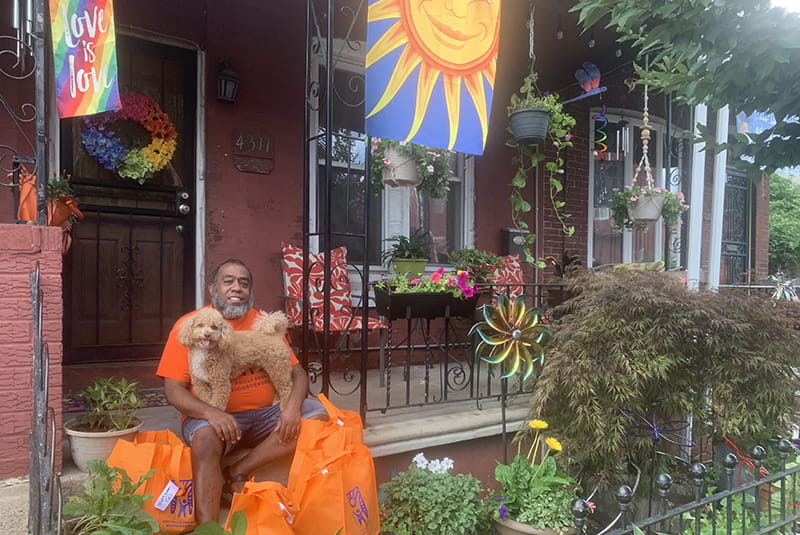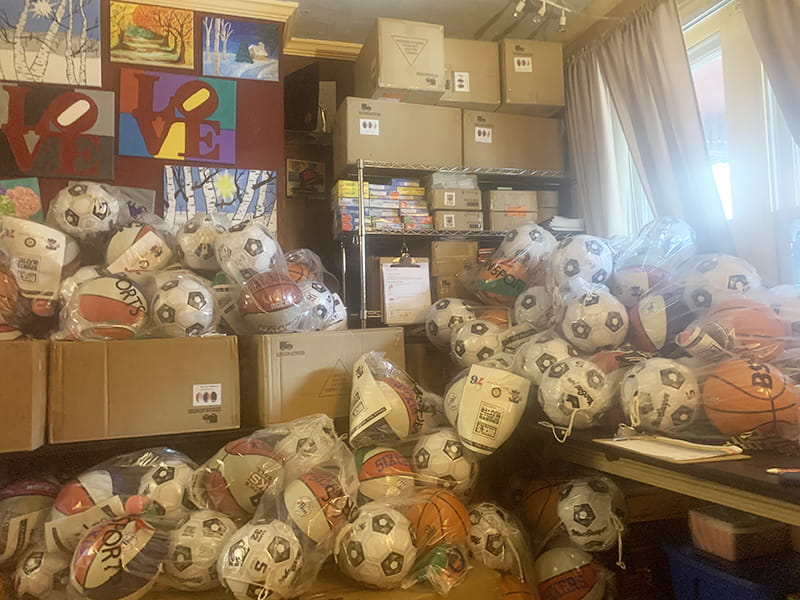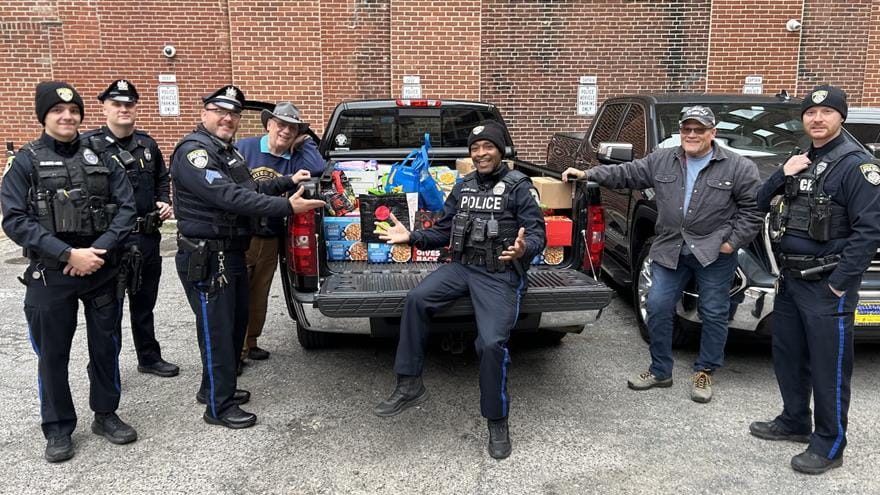Q&A: The Drexel Employee Using His Front Porch to Support the Community

Since the early days of the COVID-19 pandemic, the Promise Neighborhood team in Drexel University’s Office of University and Community Partnerships has distributed the following items to community members living in the West Philadelphia Promise Zone, a two-mile stretch of land designated by the federal government in 2014:
- 5,000+ masks
- 300 gallons of bleach
- 500+ bars of soap
- 30 gallons of hand sanitizer
- School supplies for 1,600 students
- 5,000+ summer toys and learning activities
- 2,500 pairs of earbuds
- 1,000+ books (in collaboration with Reading Recycled and Drexel’s Action For Early Learning)
- 150 basketballs, 150 soccer balls, 150 hand balls, 150 jump ropes, 150 exercise bands (in collaboration with Philadelphia Youth Sports Collaborative)
- Equipment for 12 Playstreets including 12 tarps, 24 coolers and signage
- Literature on feeding sites, COVID-19 testing locations, access centers, acquiring internet service, digital assistance, census, voting, basic COVID-19 information and much more
Even more impressive? These essential materials were distributed out of a professional staff member’s home.
When Drexel closed its campus in early March, the Promise Neighborhood team was challenged on how to get items and information out to residents living in the Promise Zone, the neighborhoods between 48th Street to the Schuylkill River, and Girard Avenue to Sansom Street. The Promise Neighborhood program is a $30 million Department of Education grant that Drexel and its partners — the School District of Philadelphia, and numerous nonprofits and community organizations — received in 2016 to improve the educational outcomes of children and families living in the Promise Zone. Promise Neighborhood Outreach Coordinator Jeffrey Jordan offered his West Belmont home as a designated resource hub and delivery address to send and pick up those items, all of which are determined by conversations with residents and partners.
More than nine months later, the “Jeffrey’s Porch” program is still going strong — and shows how the Promise Neighborhood team and the Office of University and Community Partnerships has creatively pivoted during the pandemic to respond to community need at a grassroots level.
In this edited Q&A, DrexelNow talked to Jordan about why he came up with the idea of Jeffrey’s Porch and what it has accomplished so far.
Q: Where did the idea of Jeffrey’s Porch originate from?
A: My job as outreach coordinator is to keep the Promise Neighborhood visible in the communities that we serve and to act as the “face” in the neighborhood representing the Promise Neighborhood. I try to keep the communications open between the civic associations and other organizations that I work with, as well as communicating with the Promise Neighborhood what we’ve established in order to give many voices a place at the table.
Once the pandemic hit, and we began working from home, our efforts and roles in the neighborhood shifted. We quickly realized that we need to distribute needed supplies and information to the community but we did not have a space to facilitate this with the closing of our offices. One of our partners had some supplies in their warehouse that they knew our community could benefit from, so they called me and asked me if I could figure out a way to distribute them. They brought them to my porch where we sat on opposite sides and just talked. In that moment, a lightbulb went off for me in my head knowing that my porch could become a “thing.” And from there, Jeffrey’s porch, began.
This is a testament of organizations hiring within the communities that they serve. We serve the Promise Neighborhood. And if we did not have a person working and living here, we would have had to come up with another creative way to make this all happen. But I live here. These are my neighbors. These are people who I deal with in my community that we are serving right now.
Q: If you’re living with anyone, how did that conversation go to start Jeffrey’s Porch?

A: My husband and I live together and he is very civic-minded, which is a blessing. He is the president of the West Belmont Civic Association, he sits on the Community Advisory Committee and he’s also the chairperson of the 16th District Police Advisory Board. And once a week, he picks up food from a location and distributes 30 boxes of food to neighbors. He sees and lives the needs in our community and has been very supportive in the whole process.
I remember one day he pulled out a baker’s rack from our basement to put up for all the items stored in our house. About two or three weeks after that, we realized that there still wasn’t enough shelving and we had to buy another baker’s rack to put the merchandise on.
Q: How does Jeffrey’s Porch work?
A: I do not give items to random individuals walking by! We distribute items to community leaders who in turn give items to their neighbors. We work with the heads of Mantua Civic Association, Belmont, West Belmont, Powelton Village, Saunders Park, and East Parkside. These people will send a representative to our porch and get the items to distribute to their neighbors.
Q: Where do these items come from?
A: UPS loves me! Joanne [Ferroni, director of University and Community Partnerships], my supervisor, ordered all the summer items at one time — around 50 boxes from UPS over a week. Most of the items come through the mail. And we also have partners in the community who have given things for us to distribute. And then the civic leaders will pick things up and distribute them. Throughout the summer, the Playstreet leaders came every Friday to Jefferey’s Porch to pick things up. I can talk a little more about the Playstreets if you want to do that now or later.
Q: Sure, how about now?
A: Playstreets are a City of Philadelphia initiative, through Parks and Recreation, where neighbors can petition to have the street blocked off in the summer. Once that is granted, Parks and Recreation bring meals and other things for the kids on the Playstreet. This year, because of COVID-19, we were able to get 12 Playstreets in the Promise Neighborhood. The smallest Playstreet had 20 kids. The largest had 30 kids.
We were able to step in and support those children and communities beyond what the Playstreets gave out, so the volunteers overseeing those Playstreets wouldn’t have to use things from their house or take money out of their pocket to supply things. The Promise Neighborhood, through Jeffrey’s Porch, has given each Playstreet all the items they need to operate, like food coolers and canopies and bleach and hand sanitizer and masks, as well as things like Nerf footballs and jump ropes. At one point over the summer we received a donation of 150 basketballs and 150 soccer balls for the children as well.
Q: Is there an end date to Jeffrey’s Porch?
A: I think there will be a need until the pandemic is over. The needs will change constantly, but we see there is a need. During the summer, we used Jeffrey’s Porch as a distribution site for Playstreets giving out masks, cleaning supplies, play equipment, etc. Now the needs are school focused since the children are back virtually (e.g. school supplies and books). We have also given out tons of literature and flyers on testing sites, meal sites, voting, internet access and help, housing/eviction, and the census.
Q: What were some of the rewarding experiences of Jeffrey’s Porch?
A: We have formed partnerships with the West Park public housing area in West Powelton and used Jeffrey’s Porch as another way to serve West Park and to solidify that relationship. West Park, over the summer, fed 80 kids a day. We’ve supplied them with books, footballs and water bottles. When I walk the streets of the neighborhood, I will see people with orange face masks that we gave out. It gives me joy to see those people with the masks and know that they are being safe and cautious because of something that we were able to provide for the community. The success of the Playstreets was also rewarding to me seeing the smiles on the children’s faces each day playing outside with items we gave them to have fun.
And in some ways, that’s what the Promise Neighborhood is about: supporting those community organizations and those people who are doing the work. There’s no way I can give out 300 basketballs and soccer balls, but I know 10 people that can. That’s been part of the reward of being able to utilize our community and utilize the people who are already doing the work the best way possible. Being able to help the neighbors help their community has been a blessing.
Q: Were there any other challenges during this experience?
A: Just to try to make sure Jeffrey’s Porch as safe as possible, but at the same time, I try to be in touch with what’s going on outside of my porch. I want to make sure those things that we’re supporting are safe as well. I remind my neighbors that even outside Jeffrey’s Porch, when they are giving out stuff, to follow safe practices.
Q: Is there anything else you wanted to bring up?
A: I do want to emphasize the point that the work of the Promise Neighborhood is much bigger than Jeffrey’s Porch. This is just one example of the work we are doing and I’m the vehicle that’s being used to promote something that is much, much, much bigger and involves many more people.
That’s my humble statement: that it’s not about Jeffrey and it’s not about the porch, but it’s so much more. There is so much going on with my team behind the scenes. Jeffrey’s porch is just the visible community arm in the neighborhood as part of a larger picture in the Promise Neighborhood.
In This Article
Drexel News is produced by
University Marketing and Communications.

